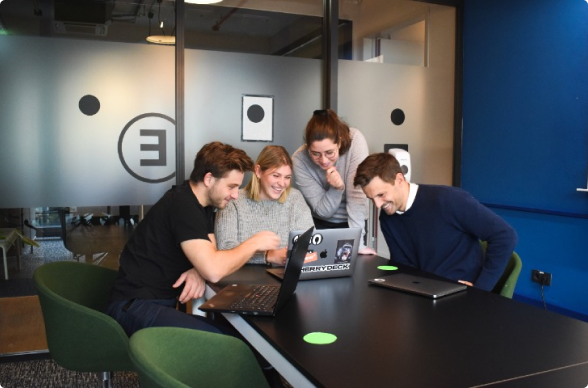How to Build User-Centric Products for B2B Software Startup
-
Odun Odubanjo
- 10 min read

 Creating genuine user-centric software requires diligence across the entire product development lifecycle. In this post, we’ll explore the key principles and best practices to help you build experiences that delight customers.
Creating genuine user-centric software requires diligence across the entire product development lifecycle. In this post, we’ll explore the key principles and best practices to help you build experiences that delight customers.
Know Your Target Audience Deeply
The first and most critical step is thoroughly understanding who your users are and what they want to accomplish. There are several research techniques to leverage:
- Surveys – Well-designed surveys provide quantitative data on user behaviors, pain points and preferences. Keep surveys focused and avoid over-surveying users.
- Interviews – One-on-one user interviews offer valuable qualitative insights. Prepare an interview guide covering goals, frustrations, workflows and more.
- Personas – Craft robust user personas synthesizing research into an archetype encapsulating behaviors, attitudes and motivations. Make personas realistic, not hypothetical.
- Scenarios – Develop user journey scenarios mapping how personas would interact with the product. Scenarios test workflows and identify usability gaps.
- Focus Groups – Facilitated discussions with 5-10 users per group provide qualitative feedback on concepts and prototypes. Recruit engaged participants.
The goal is to gather comprehensive insights that paint a complete picture of user needs. Resist making assumptions – let research data inform and guide design decisions.
In addition to functional needs, also consider the broader context and non-functional requirements like security, compliance and interoperability that shape the user experience.
Define Success Metrics Aligned to Goals
 Your goal is a user-centric product so identify quantitative and qualitative metrics that indicate whether the software meets user needs.
Your goal is a user-centric product so identify quantitative and qualitative metrics that indicate whether the software meets user needs.
Quantitative metrics track hard data on user actions. Key examples include:
- Conversion rates for desired actions like sign-ups.
- Retention/churn rates indicating user loyalty.
- Task success rates measuring ease of completing critical workflows.
- Satisfaction scores quantifying user sentiment.
Qualitative feedback offers softer, nuanced insights. Useful techniques include:
- User reviews and testimonials.
- Social listening on channels like Twitter and Facebook.
- User feedback forms and suggestion boxes.
- Moderated forums and online communities.
Ensure metrics tie directly to user personas’ goals and motivations. For example, an enterprise persona may care about uptime and support response times versus a consumer persona interested in enjoyable experiences.
As user priorities shift over time, evolve metrics accordingly. Continuously track metrics from initial development through post-launch to ensure alignment with evolving user goals.
Design Intuitive User Experiences
With research and metrics as your foundation, craft intuitive product experiences focused on seamless user workflows. Employ user experience design techniques like:
- Wireframes – Low-fidelity schematics visualizing interface layouts and information architecture. Build wireframes focused on usability.
- Prototypes – Interactive prototypes enable hands-on concept validation. Use tools like Figma, Framer and Adobe XD to create prototypes. Start low-fidelity, refine over time.
- Storyboards – Illustrate user journeys step-by-step to identify usability gaps. Convert insights into storyboards.
- Persona Stories – Craft narratives describing how personas interact with the product. Uncover use cases and opportunities.
Adhere to established interface design and usability heuristics:
💬 Questions about How to Build User-Centric Products for B2B Software Startup?
Our team typically responds within minutes
- Consistent visual language and interaction patterns
- Clear information hierarchy and minimalist aesthetics
- Accessible and inclusive features supporting diverse users
- Forgiving interfaces with clear feedback and recovery
Maintain focus on crafting experiences optimized for personas’ end-to-end workflows versus implementing individual features. Evaluate if the solution holistically helps users achieve their goals via engaging experiences.
Validate Concepts Through User Testing
 There is no substitute for direct user feedback. Conduct ongoing user testing to validate designs and uncover usability issues before launch. Useful testing methods include:
There is no substitute for direct user feedback. Conduct ongoing user testing to validate designs and uncover usability issues before launch. Useful testing methods include:
- Usability testing – One-on-one product walkthroughs to gauge intuitiveness and uncover pain points.
- A/B testing – Compare interface variants to determine what performs best.
- Beta testing – Real-world testing with early access users to validate readiness.
- Diary studies – Users self-document experiences over time to provide longitudinal insights.
- Feedback forms – Provide easy ways to share impressions within the product experience.
Adopt a collaborative, co-creative mindset when engaging users. Make them active partners in shaping the product, not just test subjects. Synthesize learnings into actionable insights versus isolated observations.
Strategically Introduce Your Product to Users
The launch introduces your solution to users. Ensure you effectively generate awareness, enthusiasm and adoption in the market:
- Messaging – Craft messaging highlighting value propositions and benefits to users. Focus on resonating with personas.
- Channels – Strategically reveal across social media, email, websites, store listings and events. Make a splash.
- Influencers – Engage influencers and media to organically amplify launch buzz.
- Referrals – Encourage existing users to refer others via incentives and social sharing.
- Pricing – Consider introductory pricing and promotions to incentivize trial.
Rollout incrementally to a small user segment first. Cautiously expand access while monitoring for issues and gathering feedback. Avoid a big bang launch without testing at smaller scale first.
Sustainably Evolve Your Product Post-Launch
Product launch is not the end – it’s just the beginning. Adopt a growth mindset committed to continuously evolving the product based on user data and feedback.
Agile frameworks like scrums enable releasing incremental enhancements frequently versus big bang launches. Consistently deploy small batches of improvements and new features versus holding them for a major release.
Open feedback channels and engage users. Make gathering user insights a habitual practice, not a one-off event. Develop a listening culture focused on users.
Analyze usage metrics and experiment with new concepts. Confirm that enhancements positively impact goals; discard what doesn’t. Maintain alignment to user needs, not internal assumptions.
By iterating the product sustainably based on real-world data, you can deliver ongoing value that helps users achieve their evolving goals.
Designing genuinely user-centric software requires diligence across the entire product development lifecycle. But the effort pays off through software that empowers and delights customers. By deeply understanding your users, crafting experiences holistically optimized for their needs, and sustaining focus post-launch, you can build software that wins with users and succeeds in the marketplace. What steps will you take today to put users first in your next project?
💬 Questions about How to Build User-Centric Products for B2B Software Startup?
Our team typically responds within minutes



